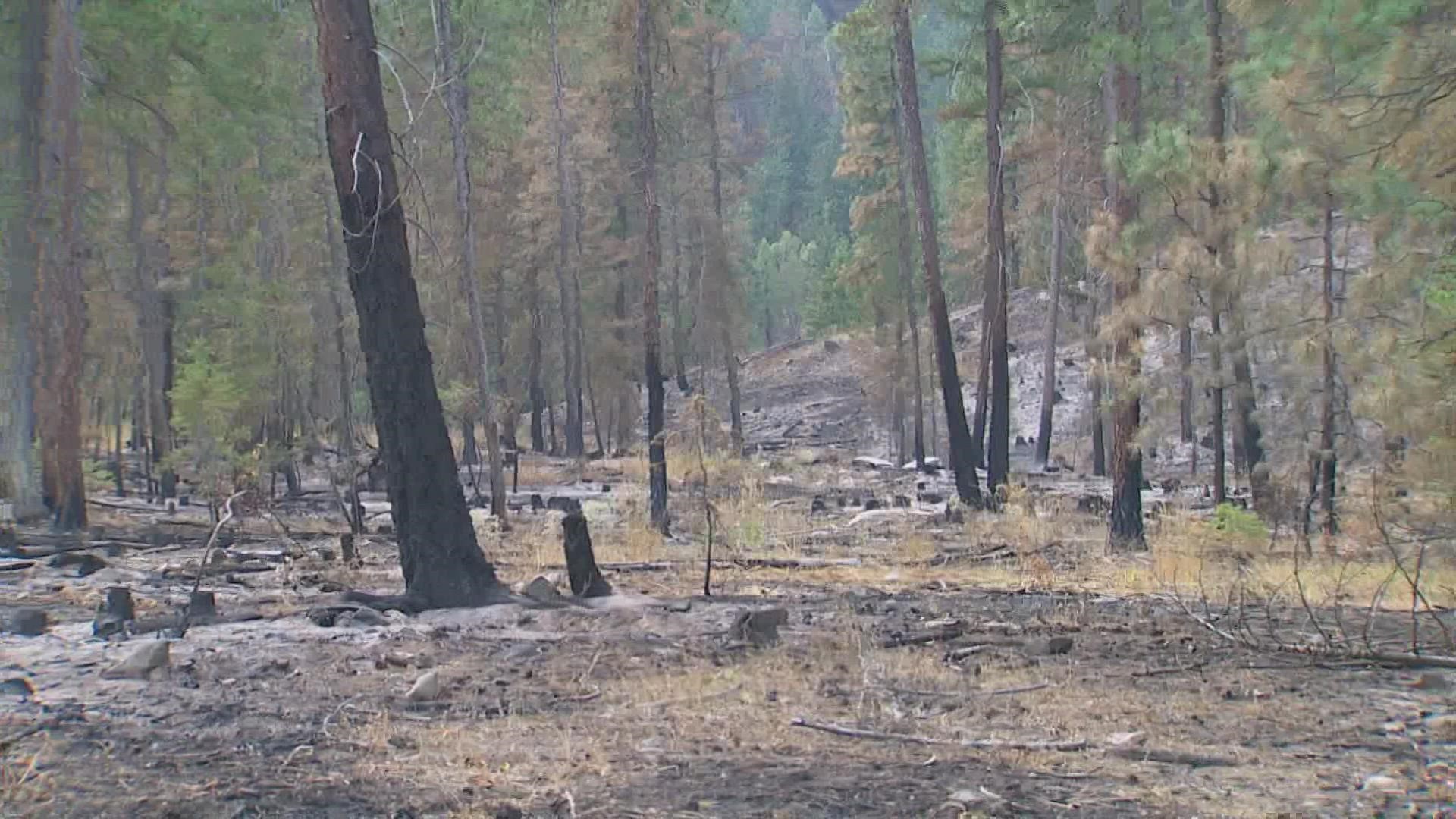WINTHROP, Wash. — Washington state is no stranger to massive and devastating wildfires.
In the wake of record fire seasons for the largest fires in 2014 and 2015, the Department of Natural Resources (DNR), which also serves as the largest wildfire-fighting agency in the state, began a Forest Health Plan to make forests more resilient to fire.
In 2019 outside the town of Winthrop in Okanogan County, the DNR thinned two stands of trees to more closely resemble forests of more than a century ago.
Central and eastern Washington forests had become choked with flammable vegetation like bushes, grasses and small trees after generations of successful fire suppression upended a natural system of low-intensity fires, which used to clear a lot of that material out.
It is why today’s fires on untreated lands are much more intense.
Now, these treated stands outside Winthrop have fewer and larger trees spaced further apart in an attempt to make those forests more fire-resistant. Last summer, the 55,000-acre Cedar Creek fire, which occurred in a tract known as Virginia Ridge Unit One, put that to the test.
“We saw at Virginia Ridge and other places in eastern Washington, they work,” said DNR Forest Health Scientist Derek Churchill. He even works for a new department within DNR called the Forest Resiliency Division. “[There are fewer] trees killed on average in these treatments, and the severity of the fire is less.”
On Virginia Ridge Unit One, the trees survived.
“We focused on Ponderosa Pine, healthy Ponderosa Pine, and focused on removing as much of the Douglas fir that we could,” said Andy Townsend, the west uplands district manager for Okanogan and western Ferry counties.
“The weather’s going to do what it’s going to do. Topography is set, so what we can do is manipulate the fuels,” said Townsend. “So, this affords managers opportunity to tie timber sales and fuels treatment together to compartmentalize the fire and hopefully limit and eliminate risks to communities.”
Virginia Ridge Unit One is timberland. Money from the sale of trees cut down and sent to mills goes to the state’s trust fund for school construction. Trees lost to wildfire is value lost to the state, according to Townsend. An out-of-control fire that sweeps onto private property burning homes, barns and private timberlands is not only value lost but a threat to lives.
The forest management strategy includes spacing out trees and sending some of them to mills. Now with less brush on the land, the remaining trees can get stronger by having less competition for soil, nutrients and water.
During a fire, the idea is that they will be less intense because there's less fuel to burn.
Dead branches are also typically cut from the trees. Brush and low-hanging branches serve as so-called “ladder fuels” which help fire climb from the ground up through the trees to the crowns, killing them.
Thick Ponderosa Pine bark has evolved to protect the trees from this lower level, low-intensity fire, which is considered a natural part of the landscape.
Townsend said it’s the first steps of an 80-year plan where trees grow and some are harvested. More trees can grow up and are harvested and protected from intense fires while still providing money to the state and protection for nearby communities.
The treatments worked in the case of Virginia Ridge Unit One, Townsend said, as the 55,000-acre Cedar Creek fire of 2021 backed down the hill and never made it past a nearby road.
“These fuel treatments, these timber sales, they provide opportunities to compartmentalize these fires and give us options to stop them,” he said.
Virginia Ridge Unit Two was not so lucky. The fire came through during the typically toughest time of the day: late afternoon with low humidity and higher winds. There was still enough fuel on the ground that the trees were killed not by fire but heat.
“If you were able to go up and look at crowns, they still have needles on them. They didn’t physically burn,” said Jake Townsend.
Jake Townsend, who isn't a relative of Andy, is the DNR’s unit forester for southern Okanogan County. “It was the intensity of the heat and the radiant heat that took a lot of those trees," he said.
It was a contrast to the circumstances for unit one, where the fire was deliberately set in what the general public would call a “back burn,” which is used by firefighters to deprive a wildfire of fuel by the time it reaches a site. The fire set on unit one came during the night, during a time of relatively high humidity and lower winds.
Yet even there, forest health scientist Derek Churchill says the number of trees lost was less than it would have been in an untreated, overgrown forest. Barns, homes and other structures that were much closer than those at Unit One did not catch fire.
Yet, there’s another factor that made the 2021 fire season worse than most.
“It was such a hot and dry summer, it was unprecedented,” said Churchill. “We had some of the lowest fuel moistures earlier in the summer than we ever had before, so people aren’t used to the fuels being that dry.”
The DNR will continue to study these and other places where fire reduction treatments have been carried out. Both units one and two left 40 trees per acre.
Should there have been fewer trees left behind?
“Conditions on the ground dictate what can be left in terms of trees that survive,” said Jake Townsend. “And sometimes they’re not going to make it.”

